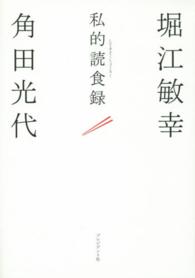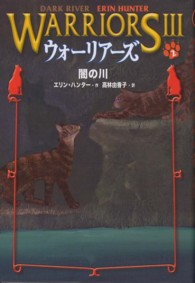- ホーム
- > 洋書
- > 英文書
- > History / World
Full Description
The Eastern Himalaya holds perhaps the highest levels of ethnolinguistic diversity in all Eurasia, with over 300 languages spoken by as many distinct cultural groups. What factors can explain such diversity? How did it evolve, and what can its analysis teach us about the prehistory of its wider region?
This pioneering interdisciplinary volume brings together a diverse group of linguists and anthropologists, all of whom seek to reconstruct aspects of Eastern Himalayan ethnolinguistic prehistory from an empirical standpoint, on the basis of primary fieldwork-derived data from a diverse range of Himalayan Indigenous languages and cultural practices.
Contributors are: David Bradley, Scott DeLancey, Toni Huber, Gwendolyn Hyslop, Linda Konnerth, Ismael Lieberherr, Yankee Modi, Stephen Morey, Mark W. Post, Uta Reinöhl, Alban Stockhausen, Amos Teo, and Marion Wettstein .
Contents
List of Tables, Figures and Maps
Introduction: Ethno-linguistic Prehistory of the Eastern Himalaya: Diversity and Its Sources
Mark W. Post, Stephen Morey and Toni Huber
Part 1 Cultural Practice and Prehistory
2 Reconsidering Zomia from an Eastern Himalayan Perspective
Mark W. Post
3 The Prehistory of Tangsa as Recorded in Traditional Songs and Stories
Stephen Morey
4 Ethnographic Comparison and Pre-history? A Comparison of Chamdam Status Rituals among the Dumi Rai of Eastern Nepal and the Feasts of Merit among the Ao Naga of Northeast India
Marion Wettstein and Alban Stockhausen
5 Principles of Naming in the Eastern Himalaya: What Can They Tell Us about Prehistory?
Yankee Modi
6 Puroik Sago Terminology
Ismael Lieberherr
Part 2 Language and Prehistory
7 Phylogeny of Tibeto-Burman from Plants and Animals
David Bradley
8 Pre-modern Language Contact in Nagaland
Amos Teo
9 Locating Kera'a (Idu Mishmi) in Its Linguistic Neighbourhood: Evidence from Dialectology
Uta Reinoehl
10 First Person Pronominals in Kuki-Naga
Scott DeLancey
11 Sound Changes from Proto-South-Central ("Proto-Kuki-Chin") to Monsang and Their Implications for the Classification of the Northwestern Languages within the South-Central Branch
Linda Konnerth
12 Kurtöp Verbal Morphology in the East Bodish Context: A Case Study in Ethnohistorical Morphosyntax?
Gwendolyn Hyslop








